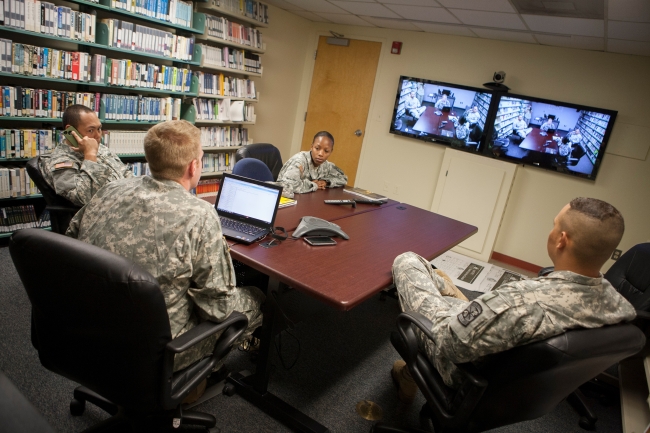You have /5 articles left.
Sign up for a free account or log in.

Many Saint Leo University students are distance learners in the military.
Saint Leo University
While the number of students taking online courses at nonprofit and public institutions continues to grow, the number of institutions offering 24/7 technical support remains low. According to the most recent data collected by WICHE Cooperative for Education Technologies (WCET), only 30 percent of colleges and universities offered round-the-clock tech support -- and that’s down from 34 percent in 2011.
“The promise of distance learning, especially when it’s asynchronous, is that a person can fit it into their lives,” said Russell Poulin, WCET’s deputy director, research and analysis. “If [students] need tech help at 2 a.m., we need to fulfill that promise.”
But many colleges and universities are making changes to better meet all students' tech-support needs. For example, the University of Central Florida in Orlando offers online tech help during the times the university found both online and on-campus students are most actively seeking it. Elisabeth Greenwood, who leads the technology support team for the institution’s Center for Distributed Learning, said the busiest hours are Monday mornings and weekdays between about 11 a.m. and 1 p.m.
UCF provides student and faculty tech support all in one shop. If one course receives 30 calls and emails in an hour, a technician is deployed to work with the faculty member to come up with a quick solution. From 9 p.m. and 11 p.m., tech help is available from staff working from home, Greenwood said.
To improve service, UCF collects and analyzes data on open help-request tickets and what times of day requests come in. On average, 15 to 20 support requests come in each week after live-tech support hours close at 11 p.m., Greenwood said.
UCF has 1,500 to 1,800 students at any given time taking classes online only, and 40 percent of its 66,000 students take at least one online course in addition to traditional classes.
At University of Maryland Baltimore County, Sherri Braxton-Lieber, director of instructional technology, said the institution’s tech team is responsive no matter the time. “Our staff is very reactive to tickets that come in after the work day, and if there is anything that is causing global issues with students we can address them as quickly as possible,” said Braxton-Lieber, who also teaches online courses.
UMBC has 13,640 students, but only offers four online classes.
Other Tech-Support Solutions
Joel Whitesel, director of the Integrated Learning Institute at Ball State University, said his institution has a help desk staffed by employees during the day, and contracts with Blackboard, an LMS company, to provide support after 7 p.m.
Blackboard provides help desk support for simple tasks, such as how to submit a paper. If the problem is more involved, the student is contacted by phone or email by staff in the morning.
Ball State employs an online proctoring service that provides basic tech help, such as checking to see if students are using the correct web browser. The service also can show learners how to use the video camera on their computers or smart phones so they use Skype or Facetime, Whitesel said.
“It’s not always possible to provide service during [all] hours," Whitesel acknowledged. “But we are trying to make options available and keep everyone flexible. The majority of the faculty [members] are willing to try anything that might make it easier for the students.”
Ball State, in Muncie, Ind., has about 20,000 students, and half take some courses online. Approximately 4,700 students only take online classes.
Optimizing Existing Programs
Institutions often have more tech-help options available than they realize. For example, “Ask a Librarian” programs often offer nontraditional help hours. Frequently, students’ tech issues are minor, such as how to upload a file, and can be answered by a librarian, said Noni Korf, director of the Digital Education and Innovation Lab at University of Michigan.
Korf, who used to work in Michigan’s IT department, is quite familiar with the tech issues remote learners face because she took online courses as a student.
Sandy Hawes, a librarian at Saint Leo University in Saint Leo, Fla., changed her work hours after a survey indicated that both online and traditional students were most likely to reach out for library help between 1 p.m. and 10 p.m. She and other staff stagger their hours to cover the times the students are most likely to contact them.
Saint Leo has about 15,800 students in 83 countries and three U.S. provinces, and Hawes said many students are in the military overseas. Approximately 2,300 are enrolled on campus.
Many universities and colleges also provide ample "frequently asked questions” sections on their websites to help students troubleshoot tech issues. Plus, some have live chat rooms that allow students taking online courses to communicate with each other and/or a proctor -- whether that's in middle of the night inside or outside of the U.S.
More Tech Help Required
Some large institutions do provide 24/7 tech support to their online learners. For instance, Penn State World Campus uses a combination of resources -- full-time tech staff, the university's central technology team and software -- to cover days, nights and weekends, said Karen Pollack, assistant vice provost for online learning and blended programs.
"It's not easy and it's expensive to do," said Pollack, adding the university also offers students online tutorials and training modules for frequently asked questions.
College officials and ed-tech experts say there will continue to be challenges, including need, funding and manpower, to providing all-day tech help for students taking online courses.
“It’s hard to jump into 24/7 tech support when you have 58 online enrollments; I understand that there is a ramp up,” Poulin said. “But if you’re going to get serious about online courses, you need to expand your support offerings.”
Hawes said she sees the need for extended-hours tech help, adding institutions have to find funding and innovative ways to provide such services. Hawes and Poulin both suggested creating consortiums with technicians from various time zones to solve tech problems for learners at multiple institutions. For example, the Connecticut Distance Learning Consortium provides services such as tutoring and tech support for online learners inside and outside of Connecticut, Poulin said.
"By planning and working together, [institutions] can have greater coverage for their students," he said.







